Dramatic Suspense Offered by Cliffhanger Scenarios
In the world of writing, advice from industry experts can be invaluable. For those seeking guidance on editing, writing, and publishing, Katie McCoach's blog is a must-visit destination [1]. McCoach, a member of Romance Writers of America and the Editorial Freelancers Association, has had essays published in TrainWrite and Kalliope, and can also be found on Twitter [1].
When it comes to cliffhangers in novel writing, treading carefully is key. Cliffhangers, defined by Dictionary.com as a melodramatic adventure serial that ends in suspense to interest the reader or viewer in the next installment, can be a powerful tool to maintain reader engagement [2]. However, they must be used thoughtfully to avoid frustrating readers or coming across as contrived.
To use cliffhangers effectively, balance suspense with some resolution while leaving key conflicts or mysteries unresolved to keep readers eager to continue. Employ foreshadowing to subtly hint at future developments, so cliffhangers feel earned and not random surprises [1].
Including emotional stakes by putting characters into dangerous, morally complex, or desperate situations deepens reader investment on what will happen next [3]. Create a list of potential conflicts unique to your characters to keep cliffhangers fresh and integral to character-driven storytelling [2].
End scenes or chapters abruptly but meaningfully, with tension unresolved or a surprise revelation that raises new questions rather than just shock value [1]. Consider different types of cliffhangers such as shocking twists, unresolved dilemmas, or revelations that shift dynamics and prompt speculation [4][5].
When resolving conflict at an ending, leave some threads open – for example, resolving the main threat but introducing a hidden danger or new problem that reinvigorates the tension [1]. Well-done cliffhangers should subtly resolve the main situation in a book while hinting at ongoing danger or suspense, as exemplified in the Harry Potter series [6].
However, ending a novel with a cliffhanger can also be deterrence, as it may leave readers feeling dissatisfied or angry about the way things were left off. Let the story and characters guide the use of cliffhangers, not the writing [7].
Katie McCoach is currently writing a contemporary romance novel, and her insights into the art of crafting effective cliffhangers are sure to be enlightening for aspiring authors.
Reading Katie McCoach's contemporary romance novel will offer insights into crafting effective cliffhangers. Books that use cliffhangers wisely, balancing suspense with resolution and leaving key conflicts unresolved, can serve as powerful sources of entertainment.





